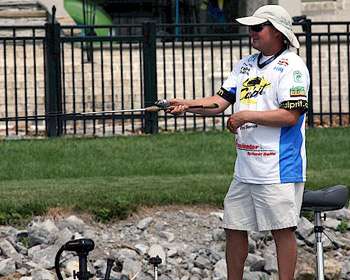
When it comes time to crank shallow water, all too often anglers just reach into their tackleboxes for a bait that has a pretty paint job and dives to the right depth.
That's a mistake, says Elite Angler Dustin Wilks, who offers up one other factor that is a prime consideration when he ties on a shallow crankbait. The North Carolina pro says his decision is based upon the lure's composition at least as much as anything else, adding that in specific situations, he prefers balsa over plastic, and vice versa. "Balsa has a quicker rise," he says. "It floats higher.
The action on plastic is a little slower." That key distinction frequently informs his choices. "I use balsa more in finesse situations, when the fish are a little finicky," he continues. "The bait is trying to climb up in the water column all the time so you really have to finesse it.
Plastic crankbaits are better when fish are more aggressive. Same with rattles — they're better when the fish are more aggressive." On a typical morning when he expects to go shallow with a diving plug, Wilks will have both balsa and plastic models available, but usually the weather will tip him off that one is likely to outfish the other. "When the bass are in a pre-frontal situation, they're more aggressive," he says. "When it's cooler, they tend to be more finicky."
Accordingly, he'll start with plastic in the former situation and balsa in the latter, but he also keeps an open mind. Sometimes the fish don't play by the rules. Historically, balsa crankbaits have been lighter than their plastic counterparts making casting a chore, especially when it's windy.
Given a substantial breeze, the light wood lures tended to sail like a potato chip. But Wilks noted that today's balsa lures, like the RJA Custom Crankbaits he typically uses, are heavier than their predecessors, so castability has become less of an issue. And if the wind is so bad that even these heavier models can't be cast effectively, he advises an angler to "just throw downwind" before switching to a less appropriate lure. With either type of crankbait, Wilks makes tackle distinctions based on the type of lip the lure features.
He typically fishes lures with rounded bills in open water, where he expects they won't come into contact with cover. He dotes on a square bill when he really wants to bang through the heavy stuff, places most anglers would pitch a spinnerbait or flip a jig or soft plastic. Therefore, he uses two different rods for cranking: a 7-foot medium-action Daiwa Steez Flex Lite for rounded bills and a 7-2 medium-heavy rod from the same line-up for the square-bills.
Regardless of which rod he uses, Wilks won't go below a 6.3:1 gear ratio baitcasting reel when shallow cranking. "A lot of times a hooked bass will swim straight at you and you have to be able to catch up," he says. "I was fishing a pond here recently and my line just went flat when I got the strike. I didn't even feel the bite because the fish was swimming toward me so fast." His line choices also vary based on the shape of the bill. "I use a little bit of mono and a little bit of fluorocarbon," he says.
"I like fluorocarbon with the square-bill because it's more durable, and mono with the round-bill bait because it enhances that light finesse action."
(Provided by Z3 Media)





